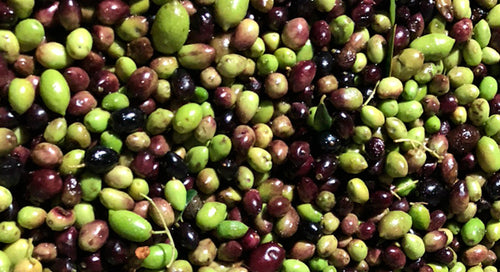The Purple Olive

There are more than 20 different types of olives, but color is not how you tell them apart. The color of an olive indicates how ripe it is, not what type it is. When olives first form, they are green, much like a new set of leaves on a tree. As the olive ripens, it changes color several times, with red and purple showing that the fruit is nearly ripe. The final color is black, indicating that the olive has fully ripened.
Certain types of olives are known by their color because they are harvested during different stages of the process. For example, if you are familiar with the Agrinion olive, you know that it is green. The Agrinion is green because it is not ripe when it is harvested, which accounts for its sour taste and very soft exterior. The different types of olives ripen at different rates as well.
Popular Purple Olives
Keeping in mind that color is indicative of ripeness, there are a number of olives that are sold when they are purple. They are not quite as ripe as the black olive, but they are much riper than a green olive. This means that you likely know these olives as purple olives because they are harvested once their color is purple.
The following are some of the most common olives harvested when they ripen to a nice purple hue.
- Alphonso olives come from Chile and undergo a unique curation process to create their distinctive bitter taste. By curing the Alphonso in either a wine or vinegar, these olives develop an even darker purple color with a soft exterior. This makes them easy to pit.
- Greek black olives can be either a dark brown or purple, not black as their name suggests. The curation process helps to soften them so that they have a very soft pulp and it is easy to remove the pits from them. They have a mild, gentle flavor that makes them enjoyable to eat.
- Kalamata olives are the most popular purple olive, and sometimes they are called Greek black olives, although they are not the same. The Kalamata olive has the deep purple hue that you likely associate with purple olives. Cured in brine, the aftertaste of this particular olive is incredibly strong. They are a very popular choice in grocery stores, and are typically kept in vinegar jars. Given their ripeness, they are incredibly easy to pit.
- Nicoise olives are small compared to many olives and are cured in salt. This French variety of olive has a dark brownish-purple color that looks inviting, but is actually tougher than you may expect. They are difficult to pit. They are unique in that the bitterness of the Nicoise olive is accompanied by a slight buttery flavor that makes it pleasing.
- Gaeta olives are the purple variant from Italy. Like the Nicoise, they are small and cured in salt. Also like the Nicoise, they can be difficult to pit, but have a very interesting flavor.
Olive Oil and Olive Ripeness
Olive oil can come in many different colors, and it will not reflect the color of the olive at the time when it was processed. However, the color of the olive is used to determine if the olive is ready for processing because the flavor is affected by how ripe the olive is. Purple olives tend to make a tamer tasting olive oil.


